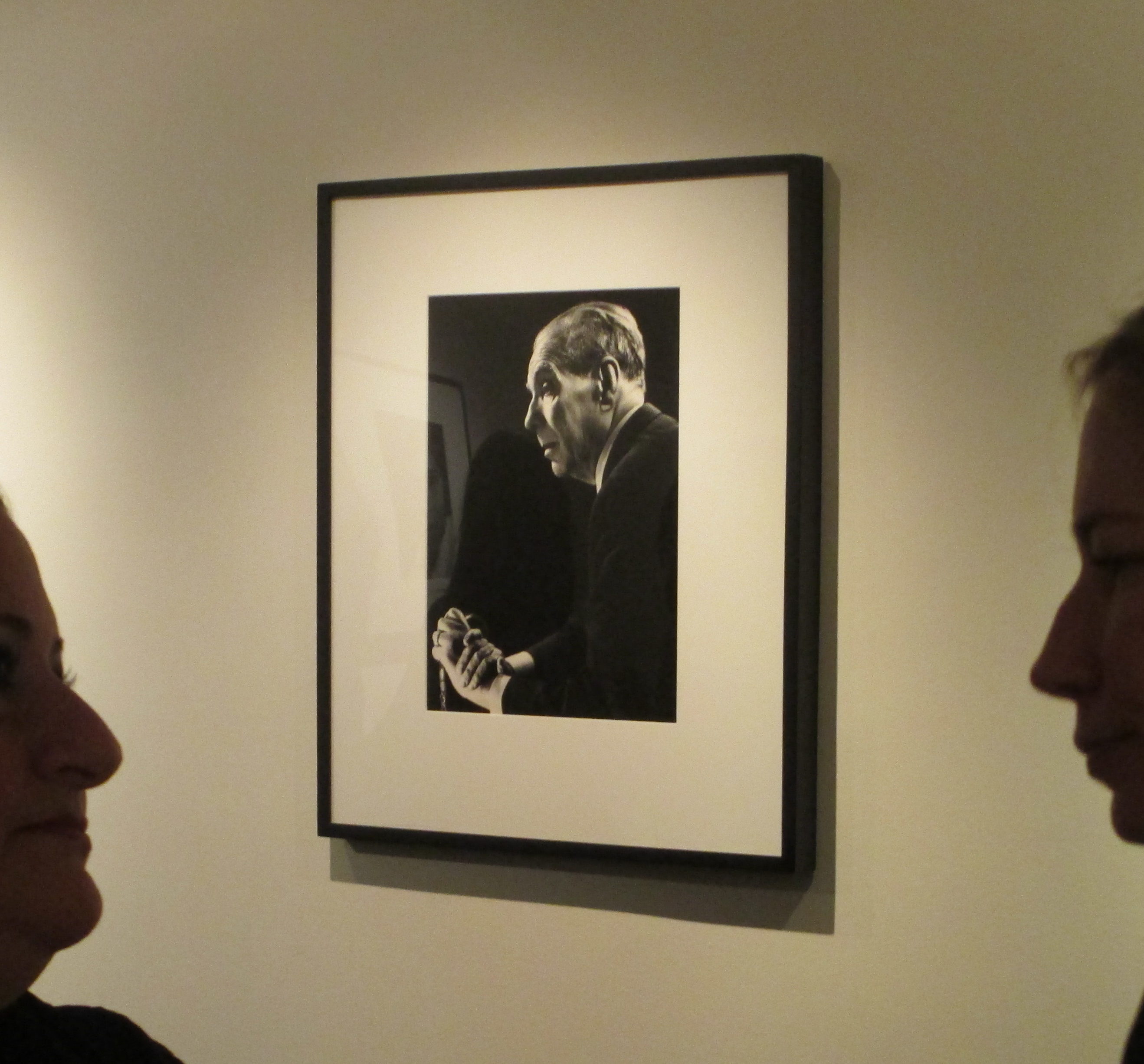They might, in an English novel, have been called “womanly,” the left perched elegantly on the grip of the cane, the right draped, like a napkin, across the opposite wrist. From there, the eye follows the arm to the crook of the elbow and up to the face. It is, the portrait, perfectly proportioned to be hung on a wall and viewed from a comfortable distance, its subject emerging from a gauzy, elegant darkness into which the blackness of his suit nearly blends. It tempts the thought, knowing he was blind when the photo was taken, that he comes to our vision out of his own darkness. Yet he is, in both senses of the word, “light,” glowing and also weightless, illuminated and delicate, captured in glamour, like a feather caught by the sun.
This is the best portrait I have seen of Borges, the inventor of Tlön, the imaginary realm, and Pierre Menard, the imaginary author; cataloger of “The Library of Babel” and its infinite shelves; parser of “the unanimous night” out of which the dreamer arrives in “The Circular Ruins.” All that is everywhere in the portrait, and nowhere. To those of us who have read him, it props a door on the impressions he left us with. To those who haven’t, it displays, with sculpted allure, something of his wit, intellect, and grace, rarefied and a bit detached, alert to sensation but inward in thought.
“Jorge Luis Borges” sits at the vanishing point of Glamour and Modernity in Buenos Aires, an exhibit of the photographs of Annemarie Heinrich at Naila Alexander Gallery. It is what attracts you, by virtue of its placement, first, and what you lose yourself in again, last, on the way out. The spell it casts with light and perspective and its subject’s fame remind us that “glamour” has several senses. It used to mean an act of magic (even today, in pop culture, vampires can “glamour” mortals). With the advent of modernity, it attached itself to the positive aura that surrounds wealth, luxury, and celebrity, a different sort of spell. In literary expression – as I first encountered in D.H. Lawrence – “glamour” can describe an aspect of natural beauty, like that of a sunset: an inherent property, neither put on nor magical, that suspends the soul in a state of wonder and appreciation.
Heinrich’s photographs cannot, of course, be called supernatural. They are too steeped in the materiality of modernity for that. They span a good portion of the modern century, ranging in the show from the ‘30s through 1966, the date of the Borges portrait. Yet for all their artistry, they feel like found images, candid even. What is caught by surprise is not, however, the serendipitous moment but something akin to the glamour of nature: modernism believed, after all, in the sublimity of form as something pure to be revealed. The subjects are often celebrities: the choreographer Anthony Tudor, the dancers Serge Lifar and Vanoye Aikens, the opera singer Marian Anderson, the poet Pablo Neruda, the actors Beba Bidart, Florence Marly and Elisa Galvé, in addition to Borges. They have, to be sure, the glamour of their fame, but it feels in Heinrich to be something in them that the culture has found and shaped. Three of them – Tudor, Marly, Bidart – are doubled by reflection or photographic technique, and it seems that while the image is split the essence is undivided. The portraits of Neruda and Anderson are, however, simpler than the others and a complement to them. In them, and especially in the strong dark eyes of Anderson, there is something more like history and less like an aesthetic spell that comprises their essence.
Heinrich, who lived from 1912 to 2005, was brought to Buenos Aires by her family in 1926. A certain amount is made, in the literature surrounding her work, of an interwar German sensibility, a sense of things seen through or displayed in windows, domestic and commercial. Her subjects seem, indeed, to be glimpsed through apertures, although there is nothing in her of the voyeur. This is, significantly, true of the anonymous nudes that, along with the portraits, are most of the exhibit. That they are open, knowing, and voluntary comes through in the attitude of the bodies, for they are faceless, and also gorgeous, like moonlit snow or sculpted marble. In the most brilliant of them, “Desnudo 6,” the pattern cast by a window shade drapes the torso and pubis of a reclining woman like squares of wet cloth form-fitting her contours. The modern sublime, in such works, transmits a glamour beyond and beneath the surface. That beauty can happen at any time and in the moment, that, however put on and contingent, there is a luster that neither mind nor culture calculates, is the glory and the hope of this vast little exhibit.
Go to Nailya Alexander Gallery for information on upcoming exhibits. For more on Annemarie Heinrich, click here.

One response to “Annemarie Heinrich”
Great article.